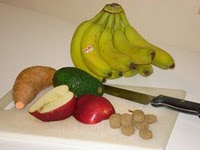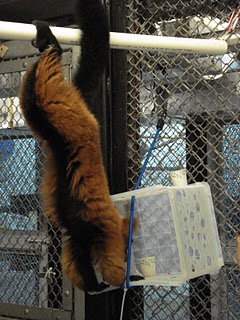
EnrichBits: A monthly look at animal enrichment
Food is a major component to our enrichment program here at the museum. Remember Enrichment and how important exhibit design is? Well, Feeding and Foraging is another big category of enrichment that we apply to our captive animals’ lives.
There are quite a few ways in which we can vary, prepare, and distribute our animals’ daily diets in order to keep things interesting for them. They’d spend much of their waking time in the wild foraging or hunting for food, and many of our animals would eat a wide variety of foods according to season, environmental conditions and preference.
With the exception of 5 year olds ( I remember my sister ate nothing but peanut butter and jelly for lunch for about a year at that age), most people like some variety in their diet too. Think of all the ways you can prepare a potato, which of those you like best, which take the longest to prepare, and how each version turns out to have a different taste or texture. For our animal diets, we vary the size of the pieces of fruit or vegetable, and sometimes we leave skin or peels on the food. Usually produce is served raw, but once a week or so, we will cook the lemurs’ sweet potato, or freeze the wolves’ mice into an ice block. Many of our animals, including the opossum, woodchuck, muskrats, chinchillas, rabbits, lemurs, box turtles and bears, get a “diet item of the day” along with the rest of their diet. In our bear diet, Wednesday’s special diet item is corn (on the cob), Thursdays – berries, Fridays are avocado days, and so on . This way our animals always get the nutrition they need, but also change and novelty.
The other way we manipulate diets to challenge our animals and to help them exhibit some of their natural behaviors is by hiding and scattering their food around their exhibits. For the lemurs, we use baskets, milk jugs, six pack holders, paper bags and paper cups as containers for their food. They have to figure out where the food is, and then manipulate the container to get to it. Our opossum might have to dig through a pile of mulch to find some of his food, and our muskrats might have to dive underwater to grab a piece of apple impaled on a stick!
 A red ruffed lemur searching for diet in paper cups.
A red ruffed lemur searching for diet in paper cups.
If you have any interesting ideas about how we can keep our animals enriched through the use of their daily diets, let us know!